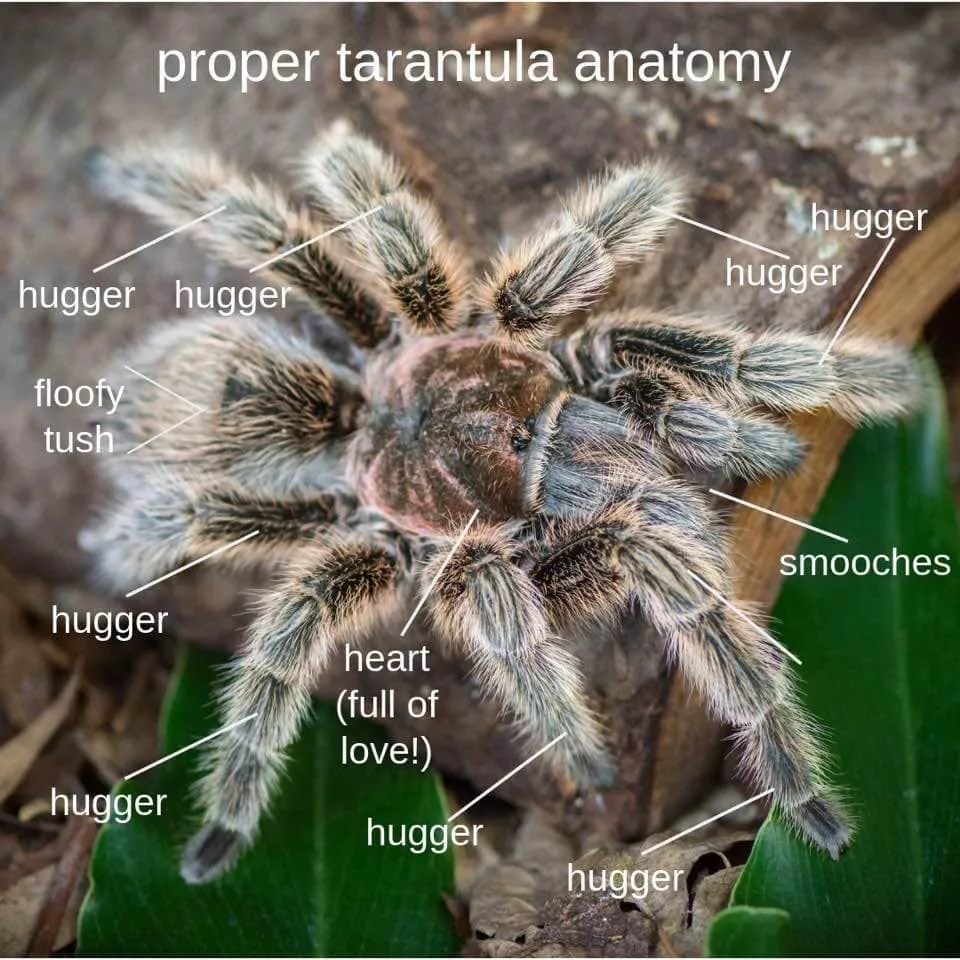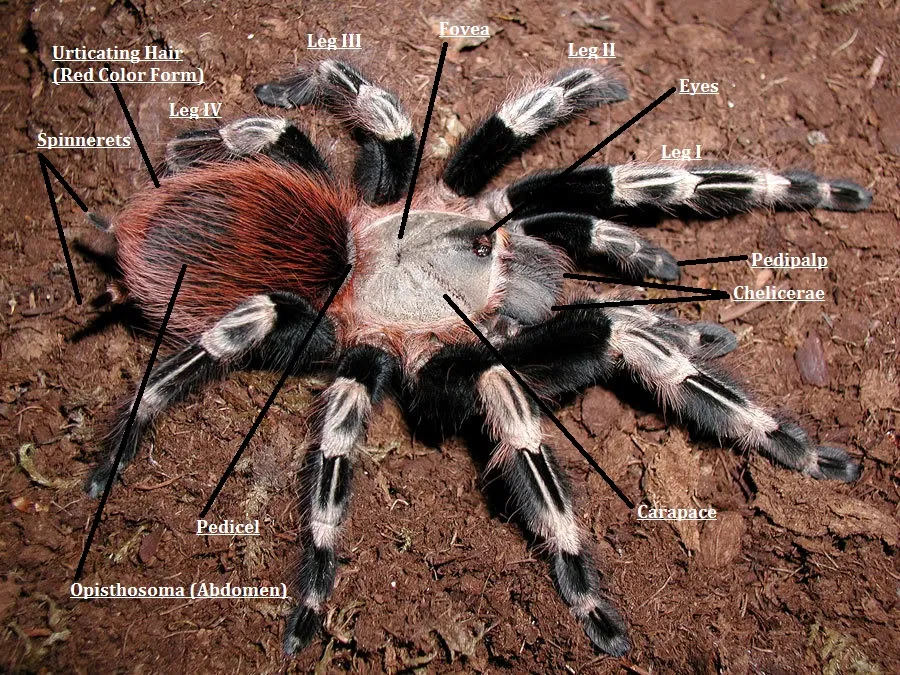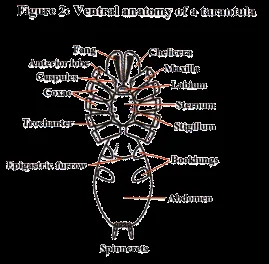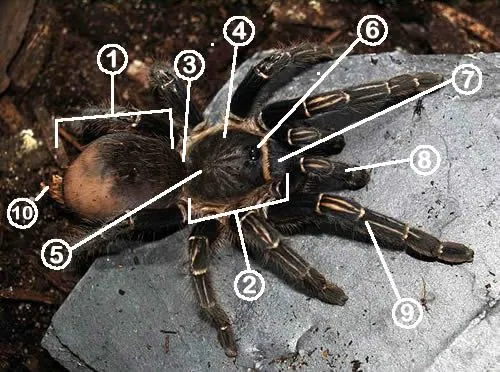The Wonders of Tarantula Anatomy
Tarantulas, those fascinating eight-legged creatures, aren’t just impressive in size and appearance; their anatomy is equally captivating. Understanding the different parts of a tarantula allows us to appreciate their unique adaptations and survival strategies. From the intricate workings of their cephalothorax to the delicate spinnerets that produce silk, every component plays a vital role in their life. This guide will take you on a detailed journey through the world of tarantula anatomy, providing a clear and concise explanation of each key structure and its function. Prepare to delve into the wonders of these amazing arachnids and discover how their bodies are perfectly designed for their environment. Let’s explore the various body parts that make tarantulas the incredible creatures they are!
The Cephalothorax A Detailed Look
The cephalothorax, also known as the prosoma, is the first major body section of a tarantula. It’s essentially the spider’s head and chest combined, acting as the central hub for many of the tarantula’s vital functions. This region is where the legs, pedipalps, mouthparts, and eyes are attached, making it a crucial area for movement, feeding, and sensory perception. The cephalothorax is protected by a hard exoskeleton, providing both support and defense. Understanding the cephalothorax is key to appreciating the tarantula’s overall structure and how it interacts with its surroundings. This complex region showcases the tarantula’s remarkable adaptations for survival in various habitats.
The Carapace

The carapace is the dorsal (upper) part of the cephalothorax, acting as a protective shield. It’s a hardened plate composed of the exoskeleton that covers and protects the vital organs within. The carapace’s shape and texture can vary depending on the tarantula species, but its primary function remains the same - to provide a robust defense against predators and environmental hazards. This tough outer layer helps the tarantula survive in its natural habitat. It is usually smooth or slightly textured and can display various colors and patterns, adding to the beauty of these creatures. The carapace’s structure is an excellent example of the tarantula’s evolutionary adaptations.
Eyes and Mouthparts
Tarantulas typically have eight eyes, arranged in different patterns depending on the species. While their eyesight isn’t as sharp as some other animals, it’s sufficient for detecting movement and light changes, which are crucial for hunting and avoiding danger. Located on the underside of the cephalothorax are the mouthparts. The chelicerae, which are the jaws, are used for biting and injecting venom. The pedipalps, often mistaken for an extra pair of legs, are used for manipulating food and sensing the environment. These mouthparts, combined with the eyes, allow the tarantula to effectively interact with its surroundings and acquire food. Together, these components allow the tarantula to sense its environment and secure its meals.
Legs and Pedipalps
The legs and pedipalps are essential for a tarantula’s mobility, feeding, and sensory perception. Each tarantula has eight legs, which are segmented, allowing for flexible movement. The pedipalps, located near the mouth, serve multiple functions, including sensing the environment, manipulating food, and, in males, transferring sperm during mating. These appendages are covered in sensory hairs that provide the tarantula with crucial information about its surroundings. From climbing to digging, the legs and pedipalps of a tarantula are incredibly versatile, contributing to its survival in various environments. The legs enable tarantulas to be agile predators, capable of both speed and precision.
Leg Segments

Each leg of a tarantula is divided into multiple segments: the coxa, trochanter, femur, patella, tibia, metatarsus, and tarsus. Each segment has a specific role in movement and providing support. The femur is the largest segment, providing the bulk of the leg’s power. The tarsus, the final segment, ends in claws that help the tarantula grip surfaces. The leg segments work together in a coordinated manner to enable the tarantula to walk, run, climb, and dig. Understanding these segments helps us appreciate the engineering of their locomotion. The segmented structure provides both flexibility and strength, allowing for efficient movement across different terrains.
Pedipalps and Their Function
Pedipalps are small appendages located near the tarantula’s mouth, often mistaken for a fifth pair of legs. They are used for various purposes, including sensing the environment, manipulating food, and, in adult males, transferring sperm. The pedipalps are covered in sensory hairs that help the tarantula detect vibrations, chemicals, and other environmental cues. Male tarantulas have specialized pedipalps with bulbous ends that are used to store and transfer sperm to the female during mating. The pedipalps play a critical role in the tarantula’s feeding habits and reproductive behavior. These versatile appendages are essential for a tarantula’s survival and reproductive success.
The Abdomen Unveiled
The abdomen is the second major body section of a tarantula, connected to the cephalothorax by a narrow pedicel. This soft, flexible part of the body houses the tarantula’s vital organs, including the heart, digestive system, and reproductive organs. The abdomen expands and contracts as the tarantula eats and digests food. The abdomen also contains the spinnerets, which are used to produce silk for various purposes, such as creating webs, building nests, and wrapping prey. It is covered with hairs that contribute to their sensory abilities and also can be used to flick at predators. The abdomen showcases a combination of flexibility, functional systems, and sensory capabilities.
Spiracles and Book Lungs

Tarantulas breathe through structures called book lungs, located on the underside of the abdomen. These lungs are named for their resemblance to the pages of a book, with thin, stacked plates that increase the surface area for gas exchange. Oxygen enters the tarantula’s body through spiracles, small openings on the abdomen that lead to the book lungs. These organs are essential for the tarantula’s respiratory system, allowing it to extract oxygen from the air. The book lungs demonstrate an evolutionary adaptation that permits the tarantula to survive in environments with varying oxygen levels. The efficiency of the book lungs is a testament to their successful adaptation.
Spinnerets and Silk Production
At the tip of the abdomen, tarantulas have spinnerets, which are organs that produce silk. These spinnerets can vary in number and shape depending on the species. They are used to create silk for a variety of purposes, including building nests, constructing retreats, wrapping prey, and creating draglines for safety. Tarantula silk is incredibly strong and versatile, and it can be used for a wide range of applications. The spinnerets are a crucial part of a tarantula’s survival toolkit, enabling it to build homes, catch food, and escape danger. Their ability to produce silk illustrates the marvels of adaptation within the tarantula’s anatomy.
Molting and Exoskeleton
Molting is a critical process in a tarantula’s life, allowing it to grow and shed its old exoskeleton. The exoskeleton, the hard outer covering, doesn’t grow, so the tarantula must shed it periodically to accommodate its increasing size. This process is a vulnerable time for the tarantula, as it is soft and defenseless until the new exoskeleton hardens. Molting is a fascinating display of nature’s resilience, as the tarantula carefully extracts itself from its old shell and emerges with a new, larger body. The molting process is also the way to regenerate lost limbs. Understanding molting provides valuable insights into tarantula growth and adaptation.
The Molting Process

The molting process involves several stages. First, the tarantula begins to form a new exoskeleton beneath the old one. Then, it absorbs fluids to swell and split the old exoskeleton. The tarantula then wriggles out of its old shell, leaving behind a perfect replica of its previous form. After molting, the tarantula is extremely vulnerable, with a soft and delicate new exoskeleton. It typically takes several days or weeks for the new exoskeleton to harden fully. During this time, the tarantula will remain hidden and inactive. This process is essential for growth, allowing the tarantula to increase in size and replace damaged body parts.
Exoskeleton Structure
The exoskeleton is a tough, protective outer layer made of chitin, a complex carbohydrate. It provides support, defense against predators, and protection from environmental hazards. The exoskeleton is segmented, allowing for movement and flexibility. Its structure varies in different parts of the body, being thicker and more robust in areas that require more protection. The exoskeleton’s composition and structure are critical to the tarantula’s survival, offering a sturdy defense system. The exoskeleton also protects the internal organs and provides attachment points for muscles, enabling the spider to move and function effectively. The unique properties of the exoskeleton play a crucial role in the survival of the tarantula.
Understanding Sensory Organs
Tarantulas rely on a variety of sensory organs to perceive their environment. These organs provide them with critical information about prey, predators, and the surrounding environment. From detecting vibrations to sensing chemicals, these organs allow the tarantula to effectively navigate and survive. Hairs, slit sensilla, and eyes all work in conjunction to provide the tarantula with a comprehensive understanding of its surroundings. Understanding how these sensory organs function offers a deeper appreciation of the complexity of tarantula adaptations and survival strategies. These organs showcase the remarkable sensory capabilities that help tarantulas thrive in their habitats.
Hairs and Their Purpose

Tarantulas have various types of hairs covering their bodies, each with a specific function. Some hairs are mechanoreceptors, which detect vibrations and air movement, while others are chemoreceptors, sensing chemicals and odors. Many species of tarantulas possess urticating hairs on their abdomen, which they can flick at potential threats as a defense mechanism. These hairs cause irritation upon contact. These sensory hairs are essential for the tarantula’s survival, providing it with critical information about its environment. The hairs aid in prey detection, predator avoidance, and communication. The diverse nature of hairs highlights the sophisticated sensory systems of tarantulas.
Sensory Abilities
Tarantulas possess a range of sensory abilities that contribute to their survival. They can sense vibrations through the hairs on their legs and body, allowing them to detect the movement of prey or potential threats. They also have chemoreceptors that help them identify food sources and potential mates. While their vision may not be the sharpest, their eyes are capable of detecting light and movement. These diverse sensory abilities allow tarantulas to effectively navigate their environments. Combining these sensory systems makes the tarantula a highly effective predator and survivor. The sophisticated interplay of these senses is a testament to their remarkable adaptations.
